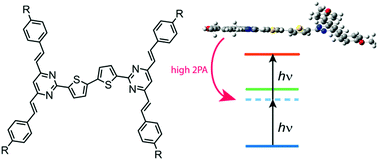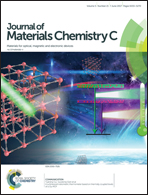A two-dimensional molecule with a large conjugation degree: synthesis, two-photon absorption and charge transport ability†
Abstract
A new molecule, 5,5′-bis(4,6-bis((E)-4-(octyloxy)styryl)pyrimidin-2-yl)-2,2′-bithiophene (OSPB), was designed and synthesized. It contains two D–π–A–π–D (donor–π–acceptor–π–donor) segments with an alkoxy group D and a pyrimidine moiety A, and these two segments are connected through a bithiophene moiety to shape a two-dimensional (2D) multibranched conjugated system. The molecule showed high thermal stability. It demonstrated good solubility in THF with an emission maximum at 470 nm, and excimer emission appeared in poor solvents such as aqueous media showing an obvious red-shift. A two-photon excited fluorescence (TPEF) test revealed that the maximal two-photon absorption (2PA) cross-section of the molecule was 1352 GM, which is comparable with the reported bipyrimidine-based multibranched compounds with a stronger donor. Theoretical calculation suggested that the molecule showed good coplanarity made up by two conjugated segments with a small dihedral angle. The charge transport ability of OSPB was preliminarily studied using an organic thin-film transistor (OTFT) device via a low-cost solution processing technique, and the results demonstrated that it was a p-type semiconductor.



 Please wait while we load your content...
Please wait while we load your content...